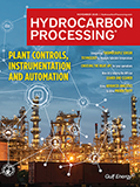Hydrogen
The heavy toll on sulfur blocks
The tightening of environmental norms and emissions specifications provides additional challenges to refining.
Decarbonizing your fired heaters with hydrogen fuel
Hydrogen has long been considered a high-value product, but not typically as a fuel for fired equipment.
Sasol, ArcelorMittal to jointly explore green hydrogen, carbon capture projects
South African petrochemicals company Sasol said it was partnering steelmaker ArcelorMittal South Africa to explore carbon capture technology and steel production using green hydrogen.
2022 HP Awards Finalists
<em>Hydrocarbon Processing</em>, the downstream processing sector’s leading technical publication for 100 yr, has announced the finalists for its sixth annual <em>HP</em> Awards, which celebrate innovative technologies and people that have been instrumental in improving facility operations over the past year.
Rolls-Royce CEO says aviation needs to act on net zero pledges
Aviation needs to accelerate the use of biofuels before new technologies like hydrogen and electric-powered aircraft become viable to limit emissions as demand for travel will not abate.
Danish Power-to-X partnership breaks ground on first of its kind green ammonia project
The partners officially started construction of the demonstration plant in Lemvig, Denmark, that will produce green ammonia based on renewable power and electrolysis of water.
Japan firms eye ammonia, methanol projects in Canada, Alberta minister says
Japanese companies are looking to invest in the Canadian province of Alberta to produce ammonia and methanol in the effort to build global supply chains of greener energy to fight climate change, a provincial minister said.
Case studies: Evaluation of the soundness and remaining life of PSA vessels with weld defects
Multiple defects were found in pressure swing adsorption (PSA) vessels during an outage of one of four PSA process units.
Chevron New Energies, Crowley lead first close of Series A funding round for Zero Emissions Industries
The new funds are expected to enable ZEI to roll out their next generation fully integrated marine power system and scale quickly to meet the demand within the maritime industry for their zero emission propulsion solutions.
Imperial advances renewable diesel plans, awards hydrogen contract to Air Products
Imperial announced a long-term contract with Air Products to supply low-carbon hydrogen for Imperial’s proposed renewable diesel complex at its Strathcona refinery near Edmonton, Alberta.

- NAPCOR releases 2024 PET recycling report highlighting system efficiency gains and continued strength of PET circularity 12/12
- OQ courts other partners for petrochemical complex in Oman as SABIC drops out 12/12
- Brazil's BNDES approves $71 MM for carbon storage project 12/12
- Cuba on edge as U.S. seizure of oil tanker puts supply at risk 12/12
- China oil demand to plateau between 2025 and 2030 12/12
- Germany's PCK refinery says no impact from pipeline leak 12/12




